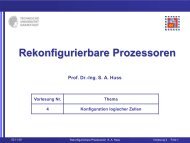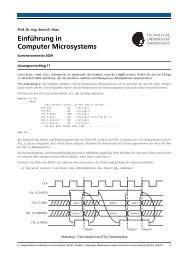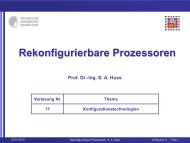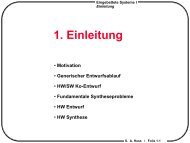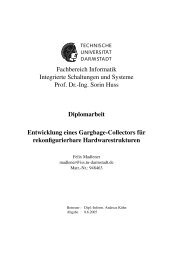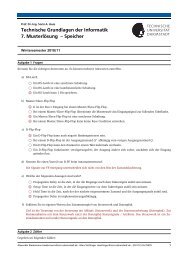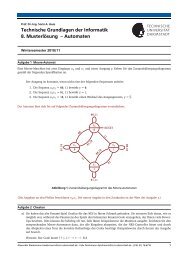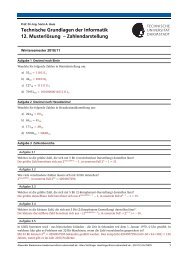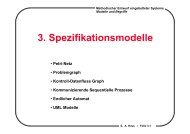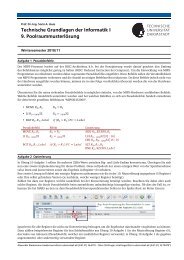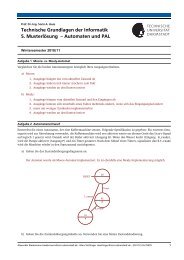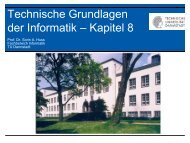FPGA based Hardware Accleration for Elliptic Curve Cryptography ...
FPGA based Hardware Accleration for Elliptic Curve Cryptography ...
FPGA based Hardware Accleration for Elliptic Curve Cryptography ...
You also want an ePaper? Increase the reach of your titles
YUMPU automatically turns print PDFs into web optimized ePapers that Google loves.
2.3. SEQUENTIAL MULTIPLICATION SCHEMES 13<br />
Due to the complexity of a reduction step, in the following this work diverts the arithmetic operations in<br />
into two successive parts. The arithmetical operation:hÁ5. corresponding to that in- and<br />
with a degreeÕ<br />
( and the subsequent reduction step.<br />
2.3 Sequential Multiplication Schemes<br />
In order to achieve a reasonable level of security <strong>for</strong> an EC cryptosystem, the extension degree ( of the<br />
underlying finite field has to be in the hundreds. Due to chip area limitations an application of<br />
combinational multipliers of full bit width ( is usually not feasible. Instead, a sequential multiplication<br />
scheme, which is <strong>based</strong> on a reasonable sized purely combinational multiplier unit, has to be utilized. In<br />
Sec. 3.4.4 the architecture of such a combinationalhÁ5. multiplier is presented, which is scalable and<br />
highly efficient in terms of required logic resources.<br />
In the remainder of this section it is assumed that a reasonable sized combinational multiplier, which<br />
computes the unreduced product of two degree +êé ( polynomials, is part of the design. Some wellknown<br />
methods <strong>for</strong> sequential multiplication are introduced first. Then, in Sec. 2.3.3, the Multi-Segment<br />
Karatsuba multiplication scheme is detailed and compared to classical approaches.<br />
2.3.1 Schoolbook Multiplication<br />
Given two polynomialsv<br />
@ |ëE -hÁ5ÃÂ of degree( and a combinational multiplier of size+<br />
6ëì(b†¦kí ,<br />
the product} 6 v |<br />
can be computed as follows: Firstv<br />
and|<br />
are split each into two segments of equal<br />
size.<br />
Then the product can be computed as<br />
6 v YC5 î 3 ¾ v ® v<br />
6 | YC5 î 3 ¾ | ® |<br />
6 v | }<br />
v Yg5 î 3 ¾ v ®ZaP| Yg5 î 3 ¾ | ® 6<br />
v YÚ | YC5 ¾Æv YÚ | ®Ú¾ v ®j | Y[º5 î 3 ¾ v ®j | ®k\ (2.10)<br />
6<br />
Please note that in the context of hardware implementations the5<br />
±<br />
factors correspond to position offsets,<br />
which can simply be implemented by appropriate wiring.<br />
Generally, the polynomials can be split into an arbitrary number of segments<br />
E”© ª<br />
. It is selected such<br />
that the resulting segments are small enough to be multiplied on the combinational multiplier (+ ³ (b†¦ ).<br />
The number of necessary multiplications is given by<br />
3<br />
. Since the additions can be computed combinationally<br />
in the same cycle, the cycle count <strong>for</strong> a complete multiplication is also given by<br />
3<br />
.<br />
A variation of the schoolbook method splits each of the two polynomialsv<br />
and|<br />
into different numbers<br />
of segments (=ïÚ@A=ð .) Of course, in this case an appropriate asymmetric combinational multiplier is necessary<br />
2 . The number of required multiplications is given here by.ïˆBPð . In the extreme case of4ï 6 ( and<br />
=ð 6 c this scheme is called bit serial multiplication.<br />
2 This topic is extensively treated in [16].



